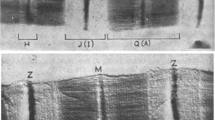Abstract
A novel actin binding protein has been isolated from chicken gizzard muscle. When isolated, a pair of proteins with apparent molecular weights of 79 kDa and 103 kDa are obtained; both proteins have a pI near 9.3. Peptide mapping indicates that these proteins are related. Antibodies against this protein cross-reacted with proteins from other smooth muscle containing tissues as well as skeletal and heart muscle. Traces of cross-reactive material were also detected in brain and kidney tissue. The affinity of this protein for actin is ca. 1 × 106 M−1. Interestingly, this actin binding protein is a potent actin-bundling agent. A partial sequence analysis confirmed that there were no previously reported homologues in smooth muscle. However, considerable homology was found with the protein synaptopodin that is found in nervous tissue and kidney but is absent from muscle tissue. It is likely that the new protein is a member of the synaptopodin family. We call the smooth muscle actin binding protein fesselin.
Similar content being viewed by others
References
Abe M, Takahashi K and Hiwada K (1990) Effect of calponin on actin-activated myosin ATPase activity. J Biochem (Tokyo) 107: 507–509.
Cantor CR and Schimmel PR (1980) Biophysical Chemistry Part II: Techniques for the Study of Biological Structures and Function (p. 680). WH Freeman, San Francisco, CA.
Chalovich JM and Pfitzer G (1997) In: Kaocy and Carsten ME (eds). Cellular Aspects of Smooth Muscle Function. Cambridge Univer-sity Press, Cambridge, UK.
Chrambach A and Rodbard D (1971) Polyacrylamide gel electropho-resis. Science 172: 440–451.
Donnelly SFH, Pocklington MJ, Pallotta D and Orr E (1993) A proline-rich protein, verprolin, involved in cytoskeletal organiza-tion and cellular growth in the yeast Saccharomyces cerevisiae. Mol Microbiol 10: 585–596.
Eisenberg E and Kielley WW (1971) Evidence of a refractory state of heavy meromyosin and subfragment-1 unable to bind to actin in the presence of ATP. Cold Spring Harbor Symp Quant Biol 37: 145–152.
Feramisco JR and Burridge K (1980) A rapid purification of a-actinin, filamin, and a 130,000-dalton protein from smooth muscle. J Biol Chem 255: 1194–1199.
Guttman A, Shieh P, Lindahl J and Cooke N (1994) Capillary sodium dodecyl sulfate gel electrophoresis of proteins II. On the Ferguson method in polyethylene oxide gels. J Chromatog A 676: 227–231.
Hoffman DR (1993) Allergens in Hymenoptera venom. XXV The amino acid sequences of antigen 5 molecules and the structural basis of antigenic cross-reactivity. J Allergy Clin Immunol 92: 707–716.
Kawasaki H, Emori Y and Suzuki K (1990) Production and separation of peptides from proteins stained with Coomassie brilliant blue R-250 after separation by sodium dodecyl sulfate-polyacrylamide gel electrophoresis. Anal Biochem 91: 332–333.
Kouyama T and Mihashi K (1981) Fluorimetry study of N-(1-pyrenyl)iodoacetamide-labelled F-actin. Local structural change of actin protomer both on polymerization and on binding of heavy meromyosin. Eur J Biochem 114: 33–38.
Lee C, Levin A and Branton D (1987) Copper staining: a five-minute protein stain for sodium dodecyl sulfate-polyacrylamide gels. Anal Biochem 166: 308–312.
Matthews JA, Batki A, Hynds C and Kricka LJ (1985) Enhanced chemiluminescent method for the detection of DNA dot-hybrid-ization assays. Anal Biochem 151: 205–209.
McGhee JD and Von Hippel PH (1974) Theoretical aspects of DNA-protein interactions: co-operative and non-co-operative binding of large ligands to a one-dimensional homogeneous lattice. J Mol Biol 86: 469–489.
Mundel P, Heid HW, Mundel TM, Krÿger M, Reiser J and Kriz W (1997) Synaptopodin: an actin-associated protein in telencephalic dendrites and renal podocytes. J Cell Biol 139: 193–204.
O'Farell PZ, Goodman HM and O'Farrell PH (1977) High resolution two-dimensional electrophoresis of basic as well as acidic proteins. Cell 12: 1133–1142.
Pearson WR (1995) Comparison of methods for searching protein sequence databases. Protein Sci 4: 1145–1160.
Rosenberg IM (1996) Protein Analysis and Purification: Benchtop Techniques. Birkhäuser-Verlag, Boston, MA.
Sobue K, Muramoto Y, Fujita M and Kakiuchi S (1981) Purifica-tion of a calamodulin-binding protein from chicken gizzard that interacts with F-actin. Proc Natl Acad Sci USA 78: 5652–5655.
Spudich JA and Watt S (1971) The regulation of rabbit skeletal muscle contraction. I. Biochemical studies of the interaction of the tropomyosin-troponin complex with actin and the porpoteolytic fragments of myosin. J Biol Chem 246: 4866–4871.
Stromer MH (1995) Immunocytochemistry of the muscle cell cyto-skeleton. Microsc Res Techni 31: 95–105.
Takahashi K, Hiwada K and Kokubu T (1986) Isolation and characterization of a 34,000-dalton calmodulin-and F-actin-binding protein from chicken gizzard smooth muscle. Biochem Biophys Res Commun 141: 20–26.
van der Loop FTL, Schaart G, Timmer EDJ, Ramaeders CS and van Eys GJJM (1996) Smoothelin, a novel cytoskeletal protein specific for smooth muscle cells. J Cell Biol 134: 401–411.
Wang K, Knipfer M, Huang Q-Q, van Hoerden A, Hsu L, Gutierrez G, Quian X-L and Stedman H (1996) Human skeletal muscle nebulin sequence encodes a blueprint for thin filament architecture. Sequence motifs and affinity profiles of tandem repeats and terminal SH3. J Biol Chem 271: 4304–4314.
Author information
Authors and Affiliations
Rights and permissions
About this article
Cite this article
Leinweber, B.D., Fredricksen, R.S., Hoffman, D.R. et al. Fesselin: a novel synaptopodin-like actin binding protein from muscle tissue. J Muscle Res Cell Motil 20, 539–545 (1999). https://doi.org/10.1023/A:1005597306671
Issue Date:
DOI: https://doi.org/10.1023/A:1005597306671




